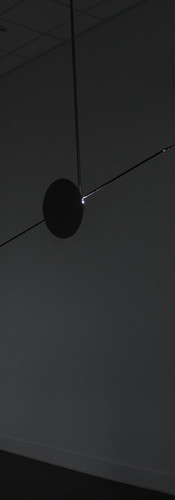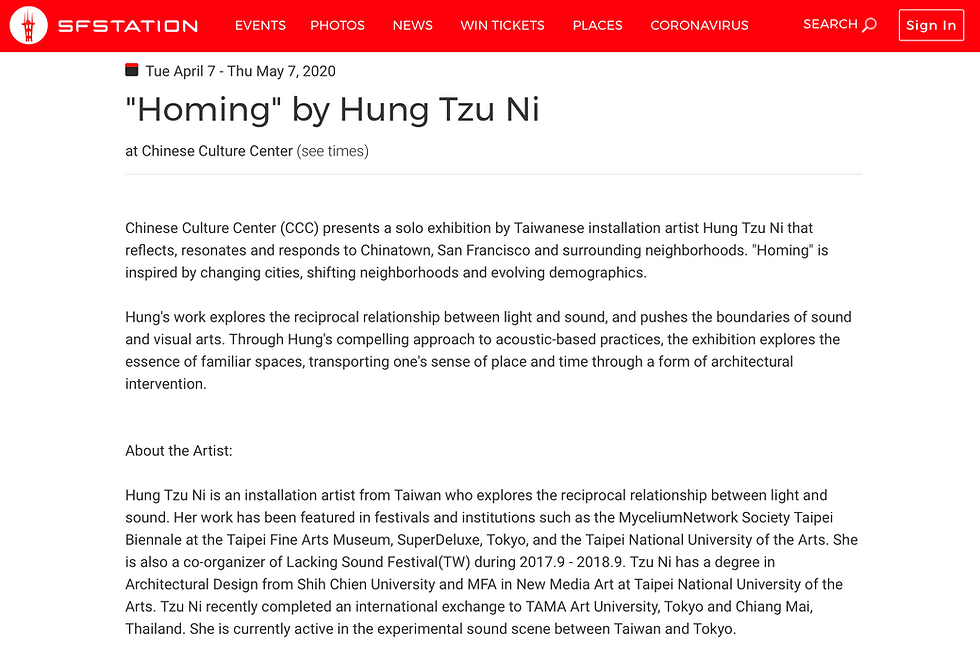Homing | 歸•巡
- Chinese Culture Center

- Feb 6, 2020
- 5 min read

Solo Exhibition by Hung Tzu Ni
Opened: February 7, 2020
CCC is uniquely positioned to provide a platform for the artists’ experimental, conceptual, and research-based practices in an environment that strikes the balance between foregrounding artistic exploration, working within a cultural community, and promoting exchange amongst wider audiences. A series of newly commissioned works by Hung Tzu Ni reflects, resonates, and responds to the unique confines of the CCC space as well as the dispositions of San Francisco Chinatown. Serving a dual meaning, Homing refers to an animal with the ability to return home and a device that has the precision to arrive at a destination.
Hung Tzu Ni (b. 1989) is a sound and installation artist based in Taiwan who explores the reciprocal relationship formed between lights and sounds in natural and urban environments. The exhibition consists of four site-specific works and is based on the artist’s research on the commercial structure, residential land, and green spaces along the four-way roads of Kearny Street, Grant Ave, Stockton Street, and Powell Street in San Francisco’s financial districts and Chinatown. For reference, Hung analyzed ambient sensations such as the decibel of machine sounds, frequencies of multilingual speakers, tempos of traffic, and the direction of sunlight.
Bay 2
In a temporal response to developing cities, changing neighborhoods, and shifting demographics, Hung adapts the gallery’s four distinct but interrelated bays into separate experiences of timespace. Bay 1 “Acoustic Measurement” is a reinterpretation on urban sounds, as a central motor dictates and speed and quality of the sound it makes. Bay 2 “The Order” is an exploration of body, space, and light. It is a series of light paths and shadows crossing and generating visual phenomena as the audience moves through the environment. Bay 3 “Reversal Inhibition” is a reflection on time. The work complicates the pulse of a second as an artificial light pierces through a series of lens that alters the imagery as it exits its sources and forms a new image at the destination. Bay 4 “Space Soundtrack” is a response to the sun’s trajectory of San Francisco. The work is situated within a day-light cycle, as it sounds to temperature shifts caused by the sun.
Bay 4
In each division of the gallery, segregated timelines, loops, and soundtracks result in an immersive experience that signals a time away from time, body away from body and home away from home. In the end, Hung’s work suggests a point of entry, exit, and return, raising the question of how we continuously define and redefine our “home” with increasing self-awareness.
Homing Livestream Performance
May 20th, 2020
Lead Artist: Hung Tzu Ni
Guest artists: Kevin Corcoran, Jorge Bachmann, Kyosuke Terada, Koki Miyabe
Homing Livestream Performance is a reimagining of the sound exhibition at CCC into a four-part audio and visual art collaboration and performance. A temporal approach to changing cities, shifting neighborhoods, and moving demographics can question how increased self-awareness within our environment contributes to global and local experiences of time. How can we process the changing time and space during the outbreak?
Program:
-- BAY1 by artists Tzu Ni with Kevin Corcoran
“Acoustic Measurement”
A reinterpretation of urban sounds, as a central motor dictates and speed
and quality of the sound it makes.
-- BAY2 by artists Tzu Ni with Kyosuke Terada
“The Order”
An exploration of body, space, and light.
-- BAY3 by artists Tzu Ni with Jorge Bachmann
“Reversal Inhibition”
A reflection on time.
-- BAY4 by artists Tzu Ni with Koki Miyabe
“Space Soundtrack”
A response to the sun’s trajectory of San Francisco.

Yu Weiying: How did you become interested in sound and installation?
Hung Tzu Ni: During my childhood, I had lots of experiences related to “Auditory Perception.” Back then, the world seemed slower than it is now, and the environment was much quieter. I felt my sense of hearing was sharper. As I became more fascinated by metal and industrial music, I began to think more abstractly about “Music” outside of symbolism and melody. Naturally, that led me to a new understanding and sensation of sound from the real world as it reacts to space. When I studied Architecture, my experience with sound further informed my approach to space in a more immaterial and abstract way.
YW: How do light and space interact in your work?
HTN: I found that light is the most fascinating material in space ? for me. I don’t think about the world in a material way, but rather in an atmospheric way, so I try to enhance the light as a material in space to de-function it as an object or sculpture while trying to find out how it interacts with the site. During this practice in space, the different interpretations of spatiality can make people think about how our bodies exist, occur, and extend in space.
YW: Urban development shapes the complex personality of San Francisco’s Chinatown, so how do you consider their impacts on residents’ and visitors’ sense of space and time?
HTN: It is interesting to walk from BART towards Chinatown. During the short 20-minute walk, the block produces different degrees of shielding and reverberations. Chinatown’s residential and commercial areas are different based on the height of the buildings from the different times when they were built, which in turn affects our sensitivity to sound and other senses. Once you arrive in Chinatown, you can feel a rise in temperature due to the sun and shorter buildings. For example, sunlight is enhanced at the open spaces in Portsmouth Square in the afternoon. The light not only illuminates physically but also psychologically; to me, it can function as a metaphor that makes people gaze or focus longer. Under this sunlight, the elderly play chess, young couples sit on benches, people stroll around the park-- it seems that time and sunshine are prolonged here.
YW: In saying that, your works are site-specific installations, in terms of your research and explorations of CCC gallery space and Chinatown, how is it manifested into this exhibition?
HTN: CCC, both as a space and location, is interesting to me as an artist because the gallery is located inside a hotel, with a unique history of how it ended up there. Architecturally, it has unique columns and ceiling. When investigating CCC’s surroundings, I focused not only on its cultural history but also on its previous urban developments. For example, there’s a monument to commemorate Scottish author Robert Louis Stevenson in 1897, but after the earthquake and the developments that led to the Portsmouth Square Parking Garage being built, the monument moved to the west side--a small piece of history symbolic to the neighborhood’s urban changes. This history inspired me to put the 4th installation in the west-facing window of the gallery, exposed to sunlight. The installation also includes a piece of paper that records and visually changes, and along with a heat sensor, the work generates a 24-hour surrounded soundscape that changes by the sun’s brightness and heat hourly as an index of time.
YW: In what ways does your work inspire audiences to capture the energies and experience of “sound”?
HTN: Not all of the work makes “real sound,” so when you enter the exhibition and walk through from the beginning to the end, the four works create an Audio/Visual environment with their own flow in coexistence with each other. Different situations will arise as people walk through the exhibition. For example, Bay 1 is a steady sound that loops per minute, and when the audience finishes Bay 1 then moves to Bay 2, they experience a radiating light sculpture moving at a 2.5/sec per minute tempo. Then, Bay 3 is silent, focusing on a light that is affected by a structure that suggests a different tempo, while Bay 4 sustains a sound in space. By that point, you will still hear the first work as sound loops per minute but you can no longer see the work. This experience will present a set of diverse experiences of “sound” in relation to time.
Media Coverage
SF/ARTS Monthly
The Daily California
Bobcut Magazine
SFSTATION
Asia Art Archive
Taipei Economic and Cultural Office in San Francisco
IN COLLABORATION WITH:
ARTIST SUPPORTED BY:

EXHIBITION SPONSORED BY:


























